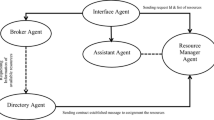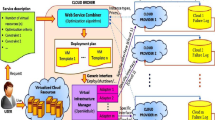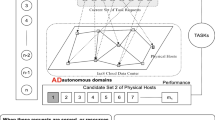Abstract
In today's dynamic business landscape, organizations heavily rely on cloud computing to leverage the power of virtualization and resource sharing. Service composition plays a vital role in cloud computing, combining multiple cloud services to fulfill complex user requests. Service composition in cloud computing presents several challenges. These include service heterogeneity, dynamic service availability, QoS (Quality of Service) constraints, and scalability issues. Traditional approaches often struggle to handle these challenges efficiently, leading to suboptimal resource utilization and poor service performance. This work presents a fuzzy-based strategy for composing cloud services to overcome these obstacles. The fact that service composition is NP-hard has prompted the use of a range of metaheuristic algorithms in numerous papers. Therefore, Particle Swarm Optimization (PSO) has been applied in this paper to solve the problem. Implementing a fuzzy-based PSO for service composition requires defining the fuzzy membership functions and rules based on the specific service domain. Once the fuzzy logic components are established, they can be integrated into the PSO algorithm. The simulation results have shown the high efficiency of the proposed method in decreasing the latency, cost, and response time.











Similar content being viewed by others
Data availability
All data are reported in the paper.
Notes
Multiple Cloud Environment.
References
Darbandi M (2017) Proposing new intelligent system for suggesting better service providers in cloud computing based on Kalman filtering. Published by HCTL International Journal of Technology Innovations and Research, 24(1): pp 1–9. ISSN: 2321-1814
Lv Z, Kumar N (2020) Software defined solutions for sensors in 6G/IoE. Comput Commun 153:42–47
Li A et al (2020) Interference exploitation precoding for multi-level modulations: closed-form solutions. IEEE Trans Commun 69(1):291–308
Zanbouri K, JafariNavimipour N (2020) A cloud service composition method using a trust-based clustering algorithm and honeybee mating optimization algorithm. Int J Commun Syst 33(5):e4259
Darbandi M (2017) Proposing new intelligence algorithm for suggesting better services to cloud users based on Kalman filtering. Published by Journal of Computer Sciences and Applications, 5(1): pp 11–16. ISSN: 2328-7268
Darbandi M (2017) Kalman filtering for estimation and prediction servers with lower traffic loads for transferring high-level processes in cloud computing. Published by HCTL International Journal of Technology Innovations and Research, 23(1): pp 10–20. ISSN: 2321–1814
Ni Q et al (2021) Continuous influence-based community partition for social networks. IEEE Trans Netw Sci Eng 9(3):1187–1197
Yao Y et al (2023) Secure transmission scheme based on joint radar and communication in mobile vehicular networks. IEEE Trans Intell Transport Syst
HaghiKashani M, Rahmani AM, JafariNavimipour N (2020) Quality of service-aware approaches in fog computing. Int J Commun Syst 33(8):e4340
Cao B et al (2021) Large-scale many-objective deployment optimization of edge servers. IEEE Trans Intell Transp Syst 22(6):3841–3849
Zhang J, Tang Y, Wang H, Xu K (2022) ASRO-DIO: active subspace random optimization based depth inertial odometry. IEEE Trans Rob 39(2):1496–1508
Li B, Tan Y, Wu A-G, Duan G-R (2021) A distributionally robust optimization based method for stochastic model predictive control. IEEE Trans Autom Control 67(11):5762–5776
Jatoth C, Gangadharan G, Buyya R (2015) Computational intelligence based QoS-aware web service composition: a systematic literature review. IEEE Trans Serv Comput 10(3):475–492
Cao B, Sun Z, Zhang J, Gu Y (2021) Resource allocation in 5G IoV architecture based on SDN and fog-cloud computing. IEEE Trans Intell Transp Syst 22(6):3832–3840
Shang M, Luo J (2021) The tapio decoupling principle and key strategies for changing factors of chinese urban carbon footprint based on cloud computing. Int J Environ Res Public Health 18(4):2101
Xie Y et al (2023) A two-stage estimation of distribution algorithm with heuristics for energy-aware cloud workflow scheduling. IEEE Trans Serv Comput
Lv Z, Chen D, Lou R, Song H (2020) Industrial security solution for virtual reality. IEEE Internet Things J 8(8):6273–6281
Karimi MB, Isazadeh A, Rahmani AM (2017) QoS-aware service composition in cloud computing using data mining techniques and genetic algorithm. J Supercomput 73(4):1387–1415
Tan J et al (2022) WF-MTD: evolutionary decision method for moving target defense based on wright-fisher process. IEEE Trans Dependable Secure Comput
Zhou G, Zhang R, Huang S (2021) Generalized buffering algorithm. IEEE Access 9:27140–27157
Li X, Sun Y (2020) Stock intelligent investment strategy based on support vector machine parameter optimization algorithm. Neural Comput Appl 32:1765–1775
Shi J et al (2023) Waveform-to-waveform end-to-end learning framework in a seamless fiber-terahertz integrated communication system. J Lightwave Technol 41(8):2381–2392
Chen G, Chen P, Huang W, Zhai J (2022) Continuance intention mechanism of middle school student users on online learning platform based on qualitative comparative analysis method. Math Probl Eng 2022:1–12
Song F et al (2020) Data-driven feedforward learning with force ripple compensation for wafer stages: a variable-gain robust approach. IEEE Trans Neural Netw Learn Syst 33(4):1594–1608
Cao B et al (2020) Multi-objective evolution of fuzzy rough neural network via distributed parallelism for stock prediction. IEEE Trans Fuzzy Syst 28(5):939–952
Cao B et al (2019) Multi-objective 3-D topology optimization of next-generation wireless data center network. IEEE Trans Industr Inf 16(5):3597–3605
de Gyvés Avila S, Djemame K (2014) Proactive adaptation in service composition using a fuzzy logic based optimization mechanism. In: CLOSER
Bai X, He Y, Xu M (2021) Low-thrust reconfiguration strategy and optimization for formation flying using Jordan normal form. IEEE Trans Aerosp Electron Syst 57(5):3279–3295
Ma K et al (2021) Reliability-constrained throughput optimization of industrial wireless sensor networks with energy harvesting relay. IEEE Internet Things J 8(17):13343–13354
Zhengcheng W (2022) Optimization of resource service composition in cloud manufacture based on improved genetic and ant colony algorithm. In: Advances in intelligent systems and computing. Springer, pp 183–198
Sefati SS, Halunga S (2022) A hybrid service selection and composition for cloud computing using the adaptive penalty function in genetic and artificial bee colony algorithm. Sensors 22(13):4873
Dimolitsas I et al (2021) Edge cloud selection: the essential step for network service marketplaces. IEEE Commun Mag 59(10):28–33
Xie N et al (2021) An efficient two-phase approach for reliable collaboration-aware service composition in cloud manufacturing. J Ind Inf Integr 23:100211
Dahan F et al (2021) An efficient hybrid metaheuristic algorithm for QoS-Aware cloud service composition problem. IEEE Access 9:95208–95217
Li W et al (2019) A trust-based agent learning model for service composition in mobile cloud computing environments. IEEE Access 7:34207–34226
Naseri A, JafariNavimipour N (2019) A new agent-based method for QoS-aware cloud service composition using particle swarm optimization algorithm. J Ambient Intell Humaniz Comput 10(5):1851–1864
Zhou J et al (2018) An adaptive multi-population differential artificial bee colony algorithm for many-objective service composition in cloud manufacturing. Inf Sci 456:50–82
Garg SK, Versteeg S, Buyya R (2013) A framework for ranking of cloud computing services. Futur Gener Comput Syst 29(4):1012–1023
Song Y et al (2023) Identifying performance anomalies in fluctuating cloud environments: a robust correlative-GNN-based explainable approach. Futur Gener Comput Syst 145:77–86
Dai X et al (2022) Task offloading for cloud-assisted fog computing with dynamic service caching in enterprise management systems. IEEE Trans Industr Inf 19(1):662–672
Hayyolalam V, Kazem AAP (2018) Review of service composition approaches in cloud environment. In: First international comprehensive competition conference on engineering sciences in Iran
Tabrizchi H, Kuchaki Rafsanjani M (2020) A survey on security challenges in cloud computing: issues, threats, and solutions. J Supercomput 76(12):9493–9532
Asghari S, Navimipour NJ (2019) Cloud service composition using an inverted ant colony optimisation algorithm. Int J Bio-Inspir Comput 13(4):257–268
Yu Q, Chen L, Li B (2015) Ant colony optimization applied to web service compositions in cloud computing. Comput Electr Eng 41:18–27
Zhang Z et al (2022) Hawk‐eye‐inspired perception algorithm of stereo vision for obtaining orchard 3D point cloud navigation map. CAAI Trans Intell Technol
Sun Y, Ma P, Dai J, Li D (2023) A cloud Bayesian network approach to situation assessment of scouting underwater targets with fixed‐wing patrol aircraft. CAAI Trans Intell Technol
Gao J, Yan X, Guo H (2022) A discrete manufacturing SCOS framework based on functional interval parameters and fuzzy QoS attributes using moving window FPA. Concurr Eng 30(1):46–66
Zhang Y, Xue W, Wei W, Nazif H (2022) A public transport network design using a hidden Markov model and an optimization algorithm. Res Transp Econ 92:101095
Hu X et al (2022) A coherent pattern mining algorithm based on all contiguous column bicluster. J Artif Intell Technol 2(3):80–92
Zhang Z et al (2022) Traffic dataset and dynamic routing algorithm in traffic simulation. J Artif Intell Technol 2(3):111–122
Cao B et al (2020) RFID reader anticollision based on distributed parallel particle swarm optimization. IEEE Internet Things J 8(5):3099–3107
Li S et al (2023) Hybrid method with parallel-factor theory, a support vector machine, and particle filter optimization for intelligent machinery failure identification. Machines 11(8):837
Cao B et al (2020) Applying graph-based differential grouping for multi-objective large-scale optimization. Swarm Evol Comput 53:100626
Cao B, Zhao J, Lv Z, Yang P (2020) Diversified personalized recommendation optimization based on mobile data. IEEE Trans Intell Transp Syst 22(4):2133–2139
Dhanachandra N, Chanu YJ (2020) An image segmentation approach based on fuzzy c-means and dynamic particle swarm optimization algorithm. Multimed Tools Appl 79(25–26):18839–18858
Wang YQ et al (2023) Scale adaptive fitness evaluation-based particle swarm optimisation for hyperparameter and architecture optimisation in neural networks and deep learning. CAAI Trans Intell Technol 8(3):849–862
Yazdanjue N, Fathian M, Amiri B (2020) Evolutionary algorithms for k-anonymity in social networks based on clustering approach. Comput J 63(7):1039–1062
Majumder A (2013) Process parameter optimization during EDM of AISI 316 LN stainless steel by using fuzzy based multi-objective PSO. J Mech Sci Technol 27(7):2143–2151
Zadeh LA (1965) Fuzzy sets. Inf Control 8(3):338–353
Zadeh LA (1975) The concept of a linguistic variable and its application to approximate reasoning—I. Inf Sci 8(3):199–249
Krishnamoorthy C, Rajeev S (2018) Artificial intelligence and expert systems for artificial intelligence engineers. CRC Press, Boca Raton
Sarkar A, Biswas A, Kundu M (2022) Development of q-rung orthopair trapezoidal fuzzy Einstein aggregation operators and their application in MCGDM problems. J Comput Cogn Eng 1(3):109–121
Comesaña-Campos A, Casal-Guisande M, Cerqueiro-Pequeño J, Bouza-Rodríguez J-B (2020) A methodology based on expert systems for the early detection and prevention of hypoxemic clinical cases. Int J Environ Res Public Health 17(22):8644
Nezhadkian M, Azimi SM, Ferro A, Nafei AH (2023) A model for new product development in business companies based on grounded theory approach and fuzzy method. J Comput Cogn Eng 2(2):124–132
Mamdani EH (1977) Application of fuzzy logic to approximate reasoning using linguistic synthesis. IEEE Trans Comput 26(12):1182–1191
Tavousi F, Azizi S, Ghaderzadeh A (2022) A fuzzy approach for optimal placement of IoT applications in fog-cloud computing. Cluster Comput:1–18
Mendel JM (2017) Uncertain rule-based fuzzy systems. Introduction and new directions, pp 684
Jeya S, Sankari L (2021) Adaptive kernel fuzzy weighted particle swarm optimized deep learning model to predict air pollution PM2. 5. Ilkogretim Online 20(5):12–23
Mansouri N, Zade BMH, Javidi MM (2019) Hybrid task scheduling strategy for cloud computing by modified particle swarm optimization and fuzzy theory. Comput Ind Eng 130:597–633
Zheng Y, Lv X, Qian L, Liu X (2022) An optimal bp neural network track prediction method based on a ga–aco hybrid algorithm. J Mar Sci Eng 10(10):1399
Piltan F et al (2011) Design adaptive fuzzy inference sliding mode algorithm: applied to robot arm. Int J Robot Autom 2(5):283–297
Clerc M (2012) Beyond standard particle swarm optimization. In: Innovations and developments of swarm intelligence applications. IGI Global, pp 1–19
Al-Masri E, Mahmoud QH (2007) Qos-based discovery and ranking of web services. In: 2007 16th international conference on computer communications and networks. IEEE
Ren X, Zhang Z, Chen S, Abnoosian K (2021) An energy-aware method for task allocation in the Internet of things using a hybrid optimization algorithm. Concurr Comput: Pract Exp 33(6):e5967
Qian L et al (2022) A new method of inland water ship trajectory prediction based on long short-term memory network optimized by genetic algorithm. Appl Sci 12(8):4073
Sakamoto S et al (2015) Analysis of WMN-HC simulation system data using friedman test. In: 2015 9th International Conference on Complex, Intelligent, and Software Intensive Systems, CISIS 2015, 8–10 July 2015, Blumenau, Santa Catarina, Brazil: proceedings. Institute of Electrical and Electronics Engineers (IEEE)
Wang X et al (2020) Block switching: a stochastic approach for deep learning security. arXiv preprint arXiv:2002.07920
Hsiao I-H, Chung C-Y (2022) AI-infused semantic model to enrich and expand programming question generation. J Artif Intell Technol 2(2):47–54
Funding
No Funding.
Author information
Authors and Affiliations
Corresponding author
Ethics declarations
Conflict of interest
The authors declare no conflict of interest.
Additional information
Publisher's Note
Springer Nature remains neutral with regard to jurisdictional claims in published maps and institutional affiliations.
Rights and permissions
Springer Nature or its licensor (e.g. a society or other partner) holds exclusive rights to this article under a publishing agreement with the author(s) or other rightsholder(s); author self-archiving of the accepted manuscript version of this article is solely governed by the terms of such publishing agreement and applicable law.
About this article
Cite this article
Nazif, H., Nassr, M., Al-Khafaji, H.M.R. et al. A cloud service composition method using a fuzzy-based particle swarm optimization algorithm. Multimed Tools Appl (2023). https://doi.org/10.1007/s11042-023-17719-2
Received:
Revised:
Accepted:
Published:
DOI: https://doi.org/10.1007/s11042-023-17719-2




